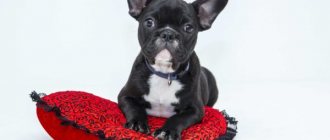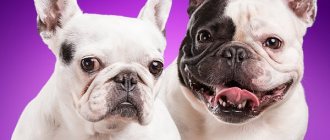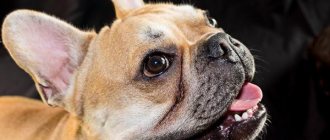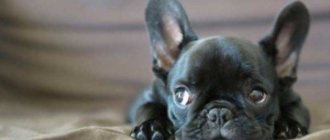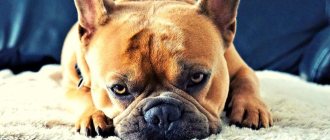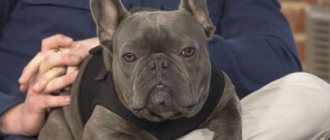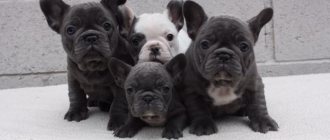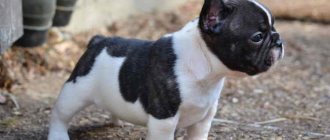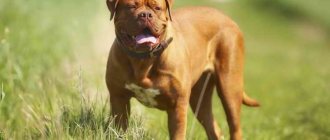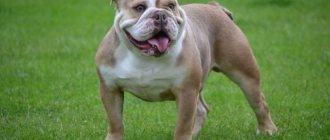The French Bulldog is a breed of elite city dog, available in different colors. Moreover, the blue French bulldog these days has become valued several times higher than others. The French Bulldog is one of the three most popular dogs in the world.
Possessing an ideal character, not requiring special care, easy to train, everyone's pet has become a prestigious dog. Among its owners are famous people, politicians, and show business stars.
Loving four-legged animals have rightfully won the hearts of Leonardo DiCaprio and Elton John, Dmitry Nagiyev and Marilyn Manson, Raisa Ryazanova and Yves Saint Laurent. French bulldogs themselves have starred in films; they can be seen in “Titanic”, “Armageddon”, “Secondhand Lions”. The brushes of great artists captured them for history in the portraits of Fyodor Chaliapin, Prince Yusupov, and the royal family of Alexander II.
A little history
The ancestors of French bulldogs are considered to be fighting and hunting dogs. France and Great Britain are still arguing over the title of the birthplace of this breed.
The English called bulldogs dogs that took part in gladiator fights. According to legend, these fighting dogs are descendants of the ancient Greek Molossian Dogs. In England, brave animals were crossed with local breeds.
And for centuries, gladiator dogs, originally from ancient Athens, entertained the royal nobility with ferocious bullfights. Even miniature toy bulldogs drove large animals to death, bringing pleasure to spectators of hard games.
- After gladiatorial combat was banned in England in 1802, the ancestors of today's French bulldogs became participants in dog fighting.
When dog fighting was banned in the middle of the 19th century, fans of brutal fights along with their pets, having lost their favorite entertainment and income, decided to leave the country.
Some of them, in search of a happy life, ended up in France, where their pets found a new use: they began to be used as rat catchers. In this capacity, the former gladiator dogs had no equal.
Resourceful Londoners made fortunes by supplying this breed from England to France. And thus, toy bulldogs moved to the European mainland.
Here, in order to achieve cuteness, smaller size and a softer character, canine immigrants began to be crossed with Spanish Alans, pugs and terriers.
- So, in 1870, a unique compact breed with a snub nose and large protruding ears was already bred, distinguished by its extraordinary devotion to man, becoming his true gentle friend, ready to protect the owner in any situation, warning of impending danger with a loud bark.
People may be frightened by the appearance of a seemingly serious dog, but in reality, the French, as the breed is otherwise called, is not capable of causing harm. He feels when they are afraid of him, and can only growl menacingly in response to a wary attitude towards the owner.
If earlier the “Frenchies” were exclusively rat catchers and guards, and their owners were the city poor and office workers, then in a short time they turned into very respectable pets, in great demand among the aristocracy. Their prices are equal to the prices of the first cars.
In 1880, residents of the French capital created a club for lovers of this breed. And after five years, the “Frenchies” were exhibited, and the breed standard was adopted. And five years later, fifty French bulldogs took part in the Paris exhibition.
French Bulldog Standard
According to the latest (1995) standard, the weight of “Frenchies” is from 8 to 14 kg, height - up to 35 cm. They live up to 15 years.
- The breed is characterized by longer (compared to the front) hind legs, which is why the appearance gives the impression of a stooped dog.
A special feature is the wide square head with large protruding eyes. A convex wrinkled forehead and a small snub nose stand out. Large, rounded at the ends, erect ears resemble bats.
The “French” muzzle is wrinkled, and there are folds on the neck. And there is a genetic explanation for this. Wrinkles protect a dog's eyes during battles from possible hemorrhage due to injury.
The body is massive, the chest is barrel-shaped, the stomach is lean. The thick tail with characteristic natural kinks does not rise above the back.
The coat is short, smooth and dense and does not require special care. Due to the lack of fluff, Frenchies do not tolerate both cold and heat well. This is an indoor dog, it does not require special long walks, it is quite content with life in a city apartment.
Color
According to the standard, two types of colors of French bulldogs can be distinguished: uniform and spotted.
The uniform color is brindle and fawn. Spotted is a color with spots on a white background.
The brindle color implies a combination of a bronze, fawn, red or black background with black or contrasting bright fur. A dark mask and white markings from muzzle to chest are acceptable.
- With a fawn color (a wide range of colors from red to light coffee), a white stripe is allowed from the forehead to the nose, and the belly must also be white.
The spotted color is characterized by a basic white background with brindle or fawn spots on the head and back, which in size should occupy no more than one-fifth of the total background.
Regardless of color, the Frenchie's cute muzzle is darker than the main color.
Not all colors are allowed for exhibitions and breeding; the following are considered non-standard: black, blue, chocolate, tri-color, lilac and gray. Dogs of this color are considered defective.
However, if you do not set yourself the task of participating in exhibitions, then these four-legged cheerful dogs will bring you great joy, becoming a devoted friend who will equally passionately love all family members.
Please note: In the United States, new colors are gradually being approved for the French Bulldog standard.
Some of the exotically colored representatives of the breed, in particular blue and cream, are already allowed to show overseas. It is hoped that in Russia blue bulldogs will soon be included in the standard.
What colors do French bulldogs have?
The brindle French bulldog is one of the most popular representatives of the breed . Such dogs look very bright, impressive and unusual. Brindle color implies the presence of red hairs on a black background, or vice versa - black on a red background.
In this case, on the muzzle there may be a difficult to distinguish mask in very dark colors or a narrow white blaze on the throat and chest. Another standard color is fawn. First of all, you need to clearly understand that this color of a French bulldog is not just one color, but a whole range of colors from bright red to café au lait.
For example, red is also classified as fawn. Fawn can be interspersed with streaks or without them. In these colors, white spots are allowed on the belly, chest and neck, as well as a white blaze on the forehead leading to the nose. The presence of white spots in other places is already considered a defect. Such dogs are not allowed to participate in exhibitions.
This is interesting! The white French Bulldog is very rare.
But here you need to understand that the white color does not actually exist, it is the absence of pigment on the coat, but there are always spots on the skin of a white bulldog, so this color is classified as spotted.
French bulldog blue color
A blue French bulldog is considered a non-standard color in Russia, and therefore a defect due to the supposedly weak blue D gene.
Please note that if your pet is blue, it will not be able to take part in exhibitions or in elite breeding.
- The blue color was obtained by breeders as a result of new discoveries in genetics. These are still the first steps in such selection.
It is still difficult for scientists to explain the appearance of such rare flowers, but dog lovers are willing to pay any money to become the owner of four-legged exotic colors.
This is precisely what explains the unexpectedly high cost of blue “French”.
Acceptable colors
In addition to standard and prohibited colors, there are also those that are on the border, that is, acceptable . Such dogs can be allowed to participate in exhibitions and even before breeding through clubs, but only if they pass the assessment of strict experts. Such colors are considered defects, but not defects of the French Bulldog breed.
Colors of French bulldogs that are not standard, but are considered acceptable. These include primarily black-tiger. This is when the dog is almost black, but still has barely noticeable inclusions of red hairs. In this case, the main thing is that the black color does not predominate, and the red inclusions are bright.
The presence of markings in the color of spotted dogs is not specified in the standard, but such representatives of the breed often become winners of prestigious exhibitions.
What's attractive about a blue jacket?
The human eye is struck by the piercing gaze of the dog's light blue eyes, reminiscent of the gaze of a husky. The coat of the French coat can be of various shades - gray, gray-blue, with blue and gray markings on a white background.
By nature, the French Bulldog is a devoted friend, slightly phlegmatic, but at the same time not averse to frolic.
Like all representatives of the breed, he cannot stand loneliness; to feel good, he needs constant communication with a person. “The French” are sociable and affectionate, they get along well even with small children.
Which color is better to choose
The color of a French Bulldog dog does not significantly affect the health, character and difficulties in care . If you set a goal to breed these cute dogs or participate in exhibitions, then the choice must certainly be made in favor of colors approved by the standard. When buying such a puppy, you need to carefully study its pedigree and find out the color of the parents. True, such specimens cost much more than their simple counterparts. When there is no such goal, then the choice of color can be any.
Recently, the blue French bulldog has become very popular; it looks interesting, but is considered a defect and is not recognized by the international canine association, but it is considered very beautiful.
The white French bulldog looks very unusual and impressive. The choice of color is a matter of taste of the dog owner. The main thing is that you will have a reliable and devoted friend and companion. These dogs are distinguished by their tender affection for all family members and color does not play a role here.

